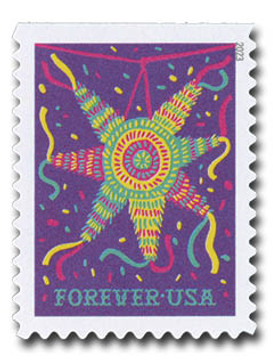
US #5814
2023 Star Piñata with Green Background – Piñatas
- Pictures a colorful star piñata representing a popular tradition in Mexican culture that has slowly spread to the United States and beyond
Stamp Category: Commemorative
Set: Piñatas
Value: 66¢ First Class Mail Rate (Forever)
First Day of Issue: September 8, 2023
First Day City: Roswell, New Mexico
Quantity Issued: 150,000,000
Printed by: Ashton Potter (USA) Ltd.
Printing Method: Offset
Format: Double-sided Booklets of 20
Tagging: Nonphosphored type III, block tagged
Why the stamp was issued: To commemorate the tradition of piñatas in Mexican culture.
About the stamp design: Pictures a colorful digital illustration of a traditional seven-point star piñata design on a vibrant green background. Artwork by Victor Meléndez.
First Day City: The First Day of Issue Ceremony was held in Roswell, New Mexico during the 36th annual Piñata Festival.
About the Piñatas set: Includes four stamps picturing digital artwork of two traditional piñata designs – donkeys and seven-point stars. The stamps are not only a celebration of piñatas as a tradition, but also as a part of Mexican culture and its importance to many Americans.
History the stamp represents: The practice of breaking containers filled with treats can be found in cultures around the world. While some aspects of modern piñatas were influenced by other cultures, much of their history is rooted in the religious practices of Mesoamerica, most notably the Aztecs.
In mid-December, the Aztecs celebrated the birthday of Huītzilōpōchtli, their patron god and god of the sun and war. Celebrations were held on the winter solstice, which marked the start of a new year as the sun rose from the longest night of the year.
Aztec priests decorated clay pots with colorful feathers. The feathers were of significance, because legend stated that Huītzilōpōchtli had been born after his mother absorbed a ball of feathers; and he was born with feathers on his body.
These decorated pots were placed in front of a statue or artwork of Huītzilōpōchtli and broken with sticks. Most of the items inside then fell at the god’s feet as an offering, while the celebrants ate the seasonal fruits from inside.
The Mayans also played a game in which they strung up decorated pots and smashed them, collecting the rewards inside. It is fascinating to see how different civilizations had similar customs and combined them to make new, shared traditions.







